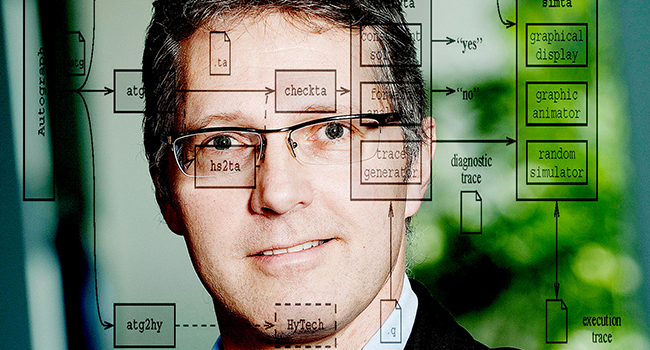Industrial and scientific evergreen from Danish computer scientist
An almost 20-year-old scientific article about a super-fast IT tool from Aalborg University is among the 10 most cited articles within software development since 1968, as shown by a new international survey comparing 70,000 contributions within the field.
Princess Diana died, Titanic filled cinemas and Aqua released Barbie Girl. In that same year, 1997, Professor Kim Guldstrand Larsen from the Department of Computer Science at Aalborg University described the tool for modelling and verification of real time IT systems that he himself had participated in developing in the years before. Since then, the article has been cited by other researchers close to 900 times, according to the research database Scopus – and close to 2,000 times according to Google Scholar.
The analytical tool UPPAAL was named after the universities in Uppsala (Sweden) and Aalborg because researchers from those two places collaborated on it. The tool makes it possible to pinpoint software errors early in the design process. As the subsequent and tenacious interest shows, it has become popular in wide circles. Not least in connection with the development of embedded software for a range of products including cars, medical equipment, production machinery and mobile phones, in which time is a crucial factor and even small delays may turn dangerous or expensive. UPPAAL can, among other things, be used for predicting whether a system will function as planned.
– It was developed during a 6-month stay in Uppsala. During the first month, we invented some brand new smart algorithms and ways of doing things. Something that used to take eight hours now only took 30 seconds. So we knew we were doing something right, Kim Guldstrand Larsen recounts.
Philips and B&O
– It was an important combination of us being much faster than everyone else and us actually being able to solve challenges that industry was facing. We used it in collaboration with B&O for analyses they were hitherto unable to perform. We found a 10-year-old error in the protocol they use for connecting all their devices, and without this they would never have found it, Kim Guldstrand Larsen recalls.
For the last 15 years, the development of UPPAAL has solely taken place in Aalborg. Updates with new options, in which a continuous series of PhD students have thrown their hearts and souls into the development, is an important element in the explanation of the tool’s longevity. At the same time, it has become a prime example of the combination of advanced theory and practical applicability that, on a good day, is the trademark of Aalborg University:
– Our roots are highly theoretical but at the same time we have had an ambition of it not being enough for us to just perform some pretty math and theory. We also wanted to turn it into tools that both we ourselves and others can utilize. That is our basic approach, Kim Guldstrand Larsen explains and uses words like ”incredible” and ”amazing” when describing his joy that people still use what he contributed to starting in the mid-90s to such a high degree.
Facts
It is the international publication Information and Software Technology which has published a new survey examining the impact of the more than 70,000 scientific articles that researchers have published within software engineering since the field picked up speed in 1968. This has been carried out by comparing how often they have been cited by other researchers. The purpose has been to identify those articles within the field that have affected others to the highest degree, and in this context, ”UPPAAL in a Nutshell” arrived in the top 10.
The article was written in collaboration with Uppsala colleagues Paul Pettersson and Wang Yi, and the computer-science trio has received awards for their efforts several times. The latest survey in Information and Software Technology shows that since publication in 1997, the article has been cited 875 times – or close to 50 times a year.
Source: AAU Matchmaking

